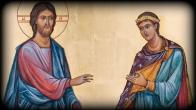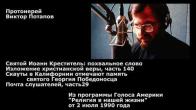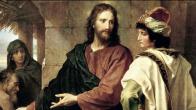You are here
May
- April 18/May 1 -- "Maximov"
- April 19/May 2 -- Mozdok
- April 20/May 3 -- "Cyprus"
- April 24/May 7 -- "Molchenskaya"
- May 1/14 -- Andronicus
- May 3/16 -- "Svenskaya" (Kiev Caves)
- May 5/18 -- "Tsarevokokshaiskaya" or "Myrrhbearers’", "Inexhaustible Cup"
- May 7/20 -- "Zhirovits"
- May 10/23 -- "Kiev-Bratskaya"
- May 14/27 -- "Terebinskaya"
- May 15/28 -- "Yaroslavl-Caves"
 The Maximov Icon of the Mother of God was written in 1299, after Holy Hierarch Maximos, Metropolitan of Vladimir (+ 1305, commemorated 6 December) had experienced a vision. On the Icon, the Mother of God is depicted at full-length, with the Pre-eternal Infant and with Metropolitan Maximos, who is kneeling before her and receiving from her hands the hierarchical omophorion. The Icon was written to commemorate the appearance to Holy Hierarch Maximox of the Most-holy Mother of God, an apparition which took place upon his arrival in Vladimir from Kiev. In the vision, the Mother of God entrusted to him an omophorion, and said: “My servant Maximos, it is good that you have visited my city. Receive this omophorion and be a shepherd to the rational sheep of my city.” Upon awakening, the Holy Hierarch found himself holding an omophorion. The appearance of the Mother of God was a sign of Divine blessing for the transfer of the Metropolitan Throne from Kiev to Vladimir. For 112 years, the omophorion given to the Holy Hierarch by the Mother of God was kept at the Dormition Cathedral in Vladimir. In 1412, during an attack by the Tatars, the omophorion was hidden by Patrick, the gatekeeper, who was martyred by the Tatars.
The Maximov Icon of the Mother of God was written in 1299, after Holy Hierarch Maximos, Metropolitan of Vladimir (+ 1305, commemorated 6 December) had experienced a vision. On the Icon, the Mother of God is depicted at full-length, with the Pre-eternal Infant and with Metropolitan Maximos, who is kneeling before her and receiving from her hands the hierarchical omophorion. The Icon was written to commemorate the appearance to Holy Hierarch Maximox of the Most-holy Mother of God, an apparition which took place upon his arrival in Vladimir from Kiev. In the vision, the Mother of God entrusted to him an omophorion, and said: “My servant Maximos, it is good that you have visited my city. Receive this omophorion and be a shepherd to the rational sheep of my city.” Upon awakening, the Holy Hierarch found himself holding an omophorion. The appearance of the Mother of God was a sign of Divine blessing for the transfer of the Metropolitan Throne from Kiev to Vladimir. For 112 years, the omophorion given to the Holy Hierarch by the Mother of God was kept at the Dormition Cathedral in Vladimir. In 1412, during an attack by the Tatars, the omophorion was hidden by Patrick, the gatekeeper, who was martyred by the Tatars.
The Mozdok Icon
19 April / 2 May
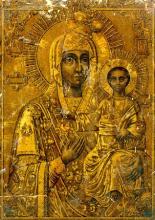 At the time Christianity became the state religion of Georgia, the numerically small Ossetian people was still serving the forces of pagan darkness. The Ossetians are one of the offshoots of the great Alan tribe, which was the dominant power in the Caucasus from the 8th through the 10th Century. It had its own Christian pastors and its own metropolitanate within the Patriarchate of Constantinople. Under attack by external enemies and by civil strife, the Alan civilization fell apart, and the clans went their own ways. Those who went farther into the hills quickly forgot Christianity, and turned to the worship of forces of nature – fire, water, stones, and holy trees. Georgian Church historians report that their bishops were unstinting in pursuing missionary activity among the various tribes. However, some of the tribes had such a strong sense of national identity that from those who spoke a different language they would accept neither their language and protection, nor even the Faith in the True God. There were people who lived in places that for most missionaries were simply inaccessible. Little clans' isolated existence prevented them from accepting the culture of neighboring tribes, and their neighbors, not knowing the language of the mountain hermits, had difficulty bringing the Gospel to peoples sitting in darkness.
At the time Christianity became the state religion of Georgia, the numerically small Ossetian people was still serving the forces of pagan darkness. The Ossetians are one of the offshoots of the great Alan tribe, which was the dominant power in the Caucasus from the 8th through the 10th Century. It had its own Christian pastors and its own metropolitanate within the Patriarchate of Constantinople. Under attack by external enemies and by civil strife, the Alan civilization fell apart, and the clans went their own ways. Those who went farther into the hills quickly forgot Christianity, and turned to the worship of forces of nature – fire, water, stones, and holy trees. Georgian Church historians report that their bishops were unstinting in pursuing missionary activity among the various tribes. However, some of the tribes had such a strong sense of national identity that from those who spoke a different language they would accept neither their language and protection, nor even the Faith in the True God. There were people who lived in places that for most missionaries were simply inaccessible. Little clans' isolated existence prevented them from accepting the culture of neighboring tribes, and their neighbors, not knowing the language of the mountain hermits, had difficulty bringing the Gospel to peoples sitting in darkness.
In the 12th Century, relations between the neighbors were restored: over the years, hurt Alan tribes that had been driven into the hilly ravines overcame their pain and offense at their neighbors, and extended their hands in friendship. At the time, at the beginning of the 13th Century, the famous Queen Tamara ascended the Georgian throne. She was the daughter of an Ossetian princess named Budjukhana, who was a pagan (as Tamara also was at first).
As often happens in the case of mixed marriages, Tamara was quite a well-rounded individual: she quickly overcame the narrowness of a pagan world-view, and received the light of Christianity, which was so brilliant on her Georgian (i.e. her father's) side. On the other hand, not being a full-blooded Georgian, she was also able to transcend personal national interests and narrow Georgian political considerations: her first husband was [the Russian] Prince George, son of Andrei Bogoliubsky.
Tamara began to concern herself with missionary activity among her Ossetian kinsmen as well. She would send them clergy, divine service books, and liturgical vessels. For the church of Ossetian Aul Maryamka in the Kuratinsk District, she sent a gift of a copy of the Iveron Icon of the Theotokos made by her personal court iconographer from the Greek original Iveron Icon. By way of Queen Tamara, the Ever-Virgin Theotokos, who had expressed the desire that «the light of knowledge of God might shine forth in ancient Ossetia, sent her Icon to it and glorified the Icon through many miracles.» Apparently, the church was a wooden one, and the place was susceptible to fires. However, «on three occasions the church burned, [but] the people found the Icon on the hill near the church, unharmed.»
On one occasion, the burning of the church turned out to be prophetic: Soon «a storm of cruel suffering and woes decimated the Ossetian land, when the impious Tatars swept across it with fire and sword.» The hand-made church's bursting into flame presaged the conflagration and woes suffered by the Church in the Ossetian land, woes it endured in the attacks by Chengiz Khan and Tamerlane. Soon thereafter, the Turks and Persians decided to divide between them the «skin of the still-living bear»: who would get the hills of Ossetia, hills which to this day are famous for their mineral resources?
However, the Mother of God pointed to a different [fate]: She, patron of a Caucuses unharmed by fiery conflagration, indicated that people who would run to the grace-filled protection of her miraculous Icon, «would move to a new place of habitation – under the protection of Russian power.» How many towns and villages became new places of habitation over the course of many years, from the mid 13th to the 18th Centuries? Thus did they wander back and forth, moving from place to place.
In 1763, pursuant to «the highest ukaz,» the fortified town of Mozdok was created, «as a place to live for the newly-baptized hill-dwellers.» By 1764, a school had already opened in the town – thanks to efforts by members of the Caucasus Mission, created in 1745 by Empress Elizaveta Petrovna.
In 1793, Empress Catherine II established the Mozdov-Madjar Vicariate of the Astrakhan Diocese. Archimandrite Gaius (Bartashvili-Takaov), a zealous missionary, was assigned to be its first bishop. His authority also extended over the town of Kizlyar. The bishop was «of bright visage» [i.e. brilliant], and quite educated (he translated the Greek classics into Georgian). Through God's Providence, he was fated to welcome and take into his hands the great holy treasure of the Caucasus – the Iveron Icon of the Mother of God, which was to become known as the «Mozdov» Icon.
From somewhere out of the hills, descendants of the ancient dwellers of Maryamka Aul in Kurtatin District, moved farther and farther away from their oppressive pagan and Muslim neighbors. On their wagon was an icon of the Mother of God. On their way, they encountered the newly-erected fortress of Mozdok, and stopped there for the night. During the night, their wagon was illuminated by a heavenly light, and in the morning, although the oxen harnessed to the wagon were lashed with whips, they could not take a single step: «Seeing that thy Icon, O Mother of God, would not move from the spot, the people of the town of Mozdok were touched to realize that this demonstrated thine abundant good will toward them, and indicated thy holy will.» People from throughout the district, along with their bishop Gaius, gathered together to pray, received the Icon, and installed it in the chapel. In 1797, the Icon was transferred to a church built to house it; the church was immediately designated a cathedral. However, two years later, the Holy Synod dissolved the diocese.
Many miracles wrought through this Icon have been recorded.
To this day, one may see a multitude of pilgrims in Mozdok on Mid-Pentecost and on the Feast of the Dormition of the Theotokos, the two days on which the Mozdok Icon of the Theotokos is commemorated.
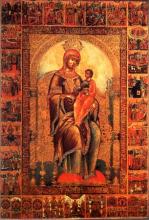 This Icon gained renown in the 4th Century on the Island of Cyprus. There, it reportedly was initially on the gates leading to one of the churches on the island. Once upon a time, a certain passing Arab was bent on committing an outrage upon the Christian holy object. He let fly an arrow, striking the knee of the Mother of God. Immediately, blood flowed from the wound, and the one who had committed the sacrilege fled in horror. He did not get far, and fell dead at the gates of his house. A monastery soon grew up on the site of the church.
This Icon gained renown in the 4th Century on the Island of Cyprus. There, it reportedly was initially on the gates leading to one of the churches on the island. Once upon a time, a certain passing Arab was bent on committing an outrage upon the Christian holy object. He let fly an arrow, striking the knee of the Mother of God. Immediately, blood flowed from the wound, and the one who had committed the sacrilege fled in horror. He did not get far, and fell dead at the gates of his house. A monastery soon grew up on the site of the church.
The Molchenskaya Icon
24 April / 7 May
The miraculous copy of the Molchenskaya Icon was found in the village of Busynovo, near Moscow. According to tradition, in the 17th Century, a blind girl who lived in the village of Busynovo found this Icon and brought it to the church.
An account by Maria Sporysheva, a parishioner of that church and long time resident.
In the 17th Century, a blind maiden lived in the village of Busynovo, in a house on the right bank of Busynka River. It happened that in a dream, the Mother of God appeared to her and told her: “Go along the right side of the river, against the current, and stand at the spot I tell you to, and you will find my Icon. The girl related everything to her mother. The next day, they went together about half a kilometer along the river. About 100 meters from the bank, the spot was revealed to them. After excavating some earth, they found a spring. Following the instructions of the Mother of God, the girl washed her eyes with water from that spring, and received her sight. The next day, the Mother of God again appeared to the maiden. She said, “Continue what you began; there is but a little more to do.” The next day, after some more excavation, the miraculous Molchenskaya Icon of the Mother of God was found. According to tradition, it is this very Icon that is currently in the Church of St. Sergius of Radonezh in Busynovo. Soon, a chapel was erected on the site where the Icon had appeared. They dug a well 1Ѕ meters deep, and installed a concrete liner. From all over Russia, the lame, crippled, and sick would come to the chapel, and through God’s mercy, many miracles took place.
The chapel survived until 1936, in the Soviet era. At the same time that the Church of St. Sergius was closed down, the chapel was destroyed. All of the candles, icons, and church utensils were thrown down into the well, and the well was filled in with earth. The miraculous Icon was handed over to the Church of the Sign Icon of the Mother of God in Aksynino.
In 1950, Maria Sporysheva and a companion were able to re-excavate and restore the well, as the location of the holy spring was known. Once again, believers would flock to the well and receive healing. Maria took care of the well until 1970, when the village of Busynovo was razed and replaced by a pipe-manufacturing complex. However, after the opening of a church in 1991, the Holy Icon once again returned to its home. For the first time in many years, a Moleben and Akathist to the Molchenskaya Icon of the Mother of God were served on December 1, 1996.
Andronicus Icon
1/14 May; October 22/November 4
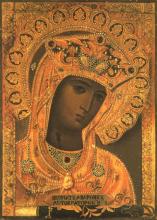 The Andronicus Icon of the Mother of God, is a miraculous icon that allegedly used to be a family icon, a holy treasure belonging to Byzantine Emperor Andronicus III Palaeologus, from whom it took its name.
The Andronicus Icon of the Mother of God, is a miraculous icon that allegedly used to be a family icon, a holy treasure belonging to Byzantine Emperor Andronicus III Palaeologus, from whom it took its name.
According to tradition, the Andronicus Icon was written by the Holy Evangelist St. Luke. According to the earliest extant documentation regarding the Icon, in 1347,
Andronicus donated it to the Monemvasia Monastery in Morea, where it remained until the early 19th Century; because of its association with that Monastery, it was also known as the Monemvasia Icon.
When many towns, including Monemvasia, were ravaged after Greece was attacked by the Turks in 1821, Bishop Agapios, abbot of the Monastery, left all of the Monastery's treasures to the enemy, except for the Miraculous Andronicus Icon, which he managed to save and take with him into hiding in Patras.Before his death, Agapios willed that Holy Icon to a relative, the Russian general consul N. I. Vlassopoulos In 1839, the general consul's son and heir, A. N. Vlassopoulos, sent it from Athens to Odessa, with an accompanying letter to His Highness Emperor Nikolai Pavlovitch, to whom the Icon was to be presented in St. Petersburg.
From 1839 to May 12 (Old Calendar) 1868, the Andronicus Icon remained at the Winter Palace, and from May 12 1868 until April 16, 1877, at Holy Trinity Cathedral in the area of St. Petersburg.
In 1877, the Icon was transferred to the Monastery of the Kazan Icon of the Mother of God near the town of Vyshiy Volotchok, in the Tver Administrative District.
The Icon was stolen in 1984, and its present whereabouts are unknown.
The Icon depicts the Theotokos to the chest, without the Divine Infant. There is a bleeding wound on the right side of the Mother of God's neck. A sheath affixed to the lower part of the Icon housed a bone handled, Damascene steel knife,with which an enemy Turk had struck the Icon; following that attack, the bleeding wound appeared on the Icon. Also affixed to the Icon was the Byzantine coat of arms - the Double-headed Eagle, attesting to the Imperial heritage of the Image. The Icon's dimensions were approximately 25 x 35 cm.
The Icon is celebrated on May 1 and October 22 (according to the Julian Calendar).
"Svenskaya" (Kiev Caves) Icon
3 / 16 May
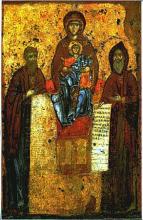 This icon was written by Venerable Alipy of the Caves. The Mother of God is depicted on this icon, seated on a throne, with her Divine Infant upon her knees. To the right of the throne stands the Venerable Theodosius, and to the left stands the Venerable Antony of the Caves. Until 1288, the icon remained in the Kiev-Caves Monastery, where it became renowned for miracles. In the following manner, it was translated in 1288 to the Bryansk-Svena Monastery of the Dormition of the Most Holy Theotokos. While in Bryansk, Roman Mikhailovich, Prince of Chernigov, became blind. Hearing of the miracles proceeding from the icon painted by Venerable Alipy himself, the prince sent a messenger to the monastery, with the request that the icon be sent to him in Bryansk, so that he might be healed. The icon, accompanied by a priest, was dispatched via the River Desna. Along its way, the boat docked on the right bank of the River Svena. The following morning, the travellers went out to the boat in order to pray before the icon. However, they did not find it there. They beheld it standing amid the branches of an oak tree, on a hill opposite the Svena River. After word of this came to Prince Roman, he was brought on foot to the icon. Praying fervently, the prince promised to build a monastery on this site, and to give to it all of the lands visible from the hill. After these prayers, the prince gradually began to regain his sight. At first, he saw the path, then nearby objects, and finally all of his surroundings. After venerating the icon, the prince had a moleben served. After the moleben, all of those present erected there a wooden church dedicated to the Dormition of the Most Holy Theotokos. They cut down the tree in which the icon had rested, and used its wood to fashion boards upon which to write other icons. At the same time, it was determined that the Svena Icon of the Mother of God would be celebrated on 3 May.
This icon was written by Venerable Alipy of the Caves. The Mother of God is depicted on this icon, seated on a throne, with her Divine Infant upon her knees. To the right of the throne stands the Venerable Theodosius, and to the left stands the Venerable Antony of the Caves. Until 1288, the icon remained in the Kiev-Caves Monastery, where it became renowned for miracles. In the following manner, it was translated in 1288 to the Bryansk-Svena Monastery of the Dormition of the Most Holy Theotokos. While in Bryansk, Roman Mikhailovich, Prince of Chernigov, became blind. Hearing of the miracles proceeding from the icon painted by Venerable Alipy himself, the prince sent a messenger to the monastery, with the request that the icon be sent to him in Bryansk, so that he might be healed. The icon, accompanied by a priest, was dispatched via the River Desna. Along its way, the boat docked on the right bank of the River Svena. The following morning, the travellers went out to the boat in order to pray before the icon. However, they did not find it there. They beheld it standing amid the branches of an oak tree, on a hill opposite the Svena River. After word of this came to Prince Roman, he was brought on foot to the icon. Praying fervently, the prince promised to build a monastery on this site, and to give to it all of the lands visible from the hill. After these prayers, the prince gradually began to regain his sight. At first, he saw the path, then nearby objects, and finally all of his surroundings. After venerating the icon, the prince had a moleben served. After the moleben, all of those present erected there a wooden church dedicated to the Dormition of the Most Holy Theotokos. They cut down the tree in which the icon had rested, and used its wood to fashion boards upon which to write other icons. At the same time, it was determined that the Svena Icon of the Mother of God would be celebrated on 3 May.
The icon became glorified for its healing of the blind and of those possessed by demons, and as a protection against enemies.
"Tsarevokokshay" or "Myrrhbearers’" Icon
5 / 18 May
This Holy Icon appeared on May 1, 1647, to a farmer named Andrew Ivanov, near the town of Bol’shiye Kuznetsy [Great Forge], about 16 kilometers from Tsarevokokshay in the province of Kazan. The Icon, carved on slate, was framed with silver and gold. The mother of God was depicted with the Myrrh-bearing Women, and for that reason is known as the Myrrh-bearers’ or Tsarevokokshaisk Icon.. Andrew prayed before it and took the Icon into his home. Many miracles began to flow from this icon, and it was soon taken to Moscow, where it was welcomed by the tsar and by the patriarch. Upon directing its return, the tsar ordered that a monastery be erected on the site of its appearance; it remained in that monastery until the Bolshevik revolution of 1917.
"Inexhaustible Cup" Icon
5/18 May
From time immemorial, Russian people have been calling upon God and His Saints in prayer for help, and have been making pilgrimages to holy sites. One of the sites is the Vysotsky Monastery in the city of Serpukhov, a place to which to this day people struggling with alcoholism stream from all over Russia. There rests the miraculous Icon of the "Inexhaustible Cup," which gained renown at the close of the 19th Century.
The type of iconography exemplified by the "Inexhaustible cup" is the third type of ancient depiction of the Mother of God, i.e. "The Sign" Icon. However, in this Icon, the Infant is depicted standing in a Chalice. The Chalice, with the Infant bestowing His blessing, is the Communion Chalice. It is by way of this Holy Chalice that Christians receive all of the blessings given mankind through Christ's redemptive podvig. This Chalice is truly inexhaustible, unconsumable, for the Lamb is "ever eaten, but never consumed."
The Mother of God stands, like a mighty high priest, with arms upraised in intercession, offering up to God this Sacrifice - Her sacrificed Son. She announces that the Inexhaustible Chalice of Divine of help and mercy has been prepared for every person in need.
Copies of the "Inexhaustible Cup" are available in the kiosk in our church.
This miraculous icon appeared in the 15th century under the following circumstances. In 1470, in woods belonging to Alexander Soltan, an Orthodox Lithuanian nobleman, shepherds from the little settlement of Zhirovits, Grodno province, witnessed an unusually bright light penetrating through the branches of a pear tree which stood next to a stream at the base of a hill. The shepherds' curiosity was aroused by such an unusual phenomenon. They came somewhat closer and saw in the tree a small icon of the Theotokos, arrayed in radiance. For a long time, the powerful light and the reverent trepidation which had seized them at the sight of this icon prevented them from approaching the icon itself. But little by little, the light emanating from the icon dissipated.
Prostrating themselves before the image of the Theotokos, the shepherds took it down from the tree and brought it to their lord, Alexander Soltan, the steward then appointed by the Lithuanian government. Alexander did not give much credence to the shepherds' account, but nonetheless took the icon and locked it up in a chest.
The next day, guests visited Soltan. In the course of conversation, the master told them of the icon of the Mother of God found by the shepherds. His guests became interested in the find, and expressed a desire to see it. Alexander went to get it, but did not find it in the chest. This exceedingly amazed him, for only a little earlier, he had seen it in its appointed place.
A short time later, the same Zhirovits shepherds again found this icon of the Theotokos in the same place, and for a second time brought it to Alexander Soltan. This time, he acted with greater piety toward the holy image than he had before. He considered himself unworthy of having the icon in his home, and made a vow to build a church dedicated to the Most Holy Theotokos on the site of Her appearance.
Soltan fulfilled his vow, and built a wooden church, near which a settlement grew, and a parish was organized. Until 1560, the holy icon remained in this church. Then, however, a fire occurred, and, despite all the efforts of the local populace to extinguish it, the fire consumed the entire church. Likewise, efforts to save the holy icon of the Theotokos from the flames proved futile. Everyone, thinking that the icon was destroyed, mourned its loss. However, the icon of the Theotokos was soon miraculously found.
Peasant children, coming home from school, came to the hill at the foot of which had stood the church which had burned down. Here they beheld a marvelous vision: an unusually beautiful Maiden, bathed in radiance, was sitting on a rock. The children did not dare approach Her, but hurried to tell their friends and relatives what they had seen. The news of the vision reached the priest as well. Accepting the children's account as a Divine revelation, they all went to the hill. When they approached the rock, they noted that on it was a lighted taper. When they came closer, they found on the rock the Zhirovits Icon of the Theotokos, not at all damaged by the fire. The priest and people of Zhirovits were inexpressibly overjoyed at the finding of their lost holy treasure. Because they had no parish church, the icon remained for some time in the home of the priest. Later, the parishioners erected a new, stone church. After it was completed, it was consecrated and dedicated to the Theotokos, and the miraculous icon was placed within.
One hundred years after these events, near the church there appeared a monastery; its tasks were educating the people of the region in the spirit of the Orthodox faith and struggling against the Unia and Roman Catholicism. The monastic brotherhood zealously fulfilled its assignment in word and deed. The monks not only dedicated themselves to their educational work among the people, but also followed a strictly ascetic way of life. Unfortunately, their work was soon forced to end. In 1618, the monastery was seized by the Uniates and remained in their hands until 1839. From that point, the miraculous Zhirovits Icon of the Theotokos also came under the control of the Uniates, who extended to it due respect and reverence. Even the Poles revered it. In 1839, the Zhirovits Monastery and the miraculous image of the Theotokos were returned to the Orthodox.
The Zhirovits Icon of the Theotokos is depicted in relief on a jasper stone, which is not of great size. It now rests to the left of the Royal Doors, in the iconostasis of the Dormition Church, the main church of the monastery built on the site of the icon's first appearance. Among the pilgrims who come to bow down before the holy icon, it is the custom to take a supply of water from the spring near which the Zhirovits Icon first appeared. Now that spring is contained in a crypt beneath the church. In addition to the water, pilgrims also take bits of stone from the rock upon which the holy icon appeared for the third time. This rock, which is noted for its great size and which is known as the "Footsteps of the Theotokos," is underneath the altar of one of the monastery churches.
"Kiev-Bratskaya" Icon
10/23 May
"Kiev-Bratskaya" Icon of the Mother of God miraculously appeared in the Church of Sts. Boris and Gleb in 1654 in the town of Vishgorod (Kiev Province). In 1662, during Russia's war with Poland (1659 - 1667), the town suffered greatly at the hands of Crimean Tatars allied with the Poles. The Church of the Holy Passion-bearers Boris and Gleb was brought to ruin, and was desecrated. However, by God's Providence the miraculous Icon of the Mother of God and the relics of Sts. Boris and Gleb were spared; the Icon had been timely removed from the church and sent down the Dniepr River, and the relics of the saints had been hidden. The Icon was carried by the river current to the banks of Podol in Kiev, where it was joyously received by the Orthodox and with due honor was taken to the Bratsk Monastery. There it remained over the course of many years. A survey of the Kiev-Bratsk Monastery church property compiled in 1807 included a description of the Icon. There was a "Song of the Miraculous Kiev-Bratskaya Icon of the Mother of God," composed shortly after 1692. The Kiev-Bratskaya Icon of the Mother of God is celebrated on three days each year: September 6, May 10, and June 2. They are all dedicated to the miraculous appearance of the Holy Icon in 1654. The original Icon is no longer extant. A copy exists in the Kiev Monastery of the Protection of the Mother of God.
The Terebinskaya Icon
14/27 May
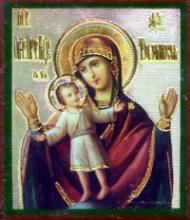 The Terebinskaya Icon of the Theotokos is in the Terebinsk Hermitage of St. Nicholas the Wonder-worker, in Tver Diocese. In this Icon, the Most-holy Theotokos is depicted at waist-length, with arms upraised. The Divine Infant is depicted at full-length, with outspread arms, and standing on a globe. This Icon is mentioned along with other miraculous icons in various documents of great antiquity, but no detailed accounts of the Icon exist. It is known that it appeared in 1654 next to the Terebinsk Hermitage, from which it got its name.
The Terebinskaya Icon of the Theotokos is in the Terebinsk Hermitage of St. Nicholas the Wonder-worker, in Tver Diocese. In this Icon, the Most-holy Theotokos is depicted at waist-length, with arms upraised. The Divine Infant is depicted at full-length, with outspread arms, and standing on a globe. This Icon is mentioned along with other miraculous icons in various documents of great antiquity, but no detailed accounts of the Icon exist. It is known that it appeared in 1654 next to the Terebinsk Hermitage, from which it got its name.
The Icon currently in the Terebinsk Hermitage is a copy; the location of the original is unknown. According to some accounts, it was taken to the St. Sophia Cathedral in Novgorod.
The St. Nicholas-Terebinsk monastery is in a picturesque area in the Bezhetsk heights on the banks of the river Mologa (which is now the village of Sloboda, Maxatikhin Region). The Monastery was founded in 1641 on the site of a wooden church that had been erected in 1492 by a landowner named Mikhail Obutkov in the village of Terebeny, and dedicated to Holy Hierarch St. Nicholas. Obutkov moved his most precious icons, including the Terebinsk Icon of the Mother of God, and a miraculous Icon of St. Nicholas, into that Church.
Following the October Revolution, the monastery continued to function. In the early 1930s, the monastery was shut down. The Bolsheviks confiscated its property, and on its grounds they set up an agricultural fertilizer warehouse. In 1992, church life in the monastery began again. In 1995, restoration of the churches began, and in the summer of 1999, the peal of bells in the monastery once again rang out.
"Yaroslavl-Caves" Icon
15/28 May
In Yaroslavl, a woman named Alexandra Dobychkina suffered for 17 years with a terrible illness: At first she had to endure depression, and then to suffer aching pain in her hands and in all of her joints, which caused her to scream in agony. In 1823, she had a dream in which she saw a certain church and, in it, an Icon of the Mother of God. Later, she went from church to church, looking everywhere for such a church. Finally she came to the Yaroslavl diocesan center. Here, near the bell-tower, she saw the church of the Procession of the Most-Precious Cross, and recognized it to be the church she had seen in her dream. She entered the church with a feeling of joyous anticipation, and as soon as she had seen, written on the wall, the Caves Icon of the Mother of God, she was suddenly thrown to the floor, her entire body in convulsions. Upon coming to herself, she experienced the distinct hope that she would receive from the Icon of the Mother of God which she had seen in her dream healing from the ills which had beset her for many years. The next day, she again visited this church. Fervently praying before the Icon, she attempted to venerate it, but suddenly felt within herself some kind of strange and powerful movement. At that moment, she received complete healing from her sickness. From that point, through the grace of the Mother of God, countless miracles began to flow from the Icon to all who run to her with faith.
PARISH LIFE
RECENT VIDEOS
Address of our Cathedral
Subscribe to our mailing list
While all the materials on this site are copyrighted, you may use them freely as long as you treat them
with respect and provide attribution on the Russian Orthodox Cathedral of St.John the Baptist of Washington DC.



